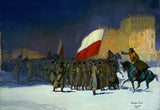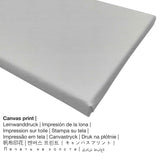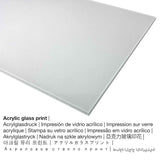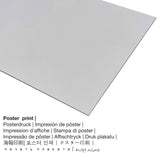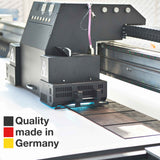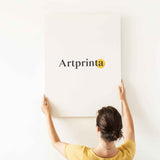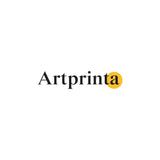George Benjamin Luks, 1918 - Ndị agha Czechoslovakia na-abanye Vladivostok, Siberia, na 1918 - mbipụta nka mara mma.
Ụtụ gụnyere. Mbupu gbakọrọ na ndenye ọpụpụ.
Họrọ ihe ngwaahịa gị
Anyị na-enye ụdị dị iche iche nha na ihe maka ngwaahịa ọ bụla. Ka ị kwekọọ n'ihe ị chọrọ nke ọma, ị nwere ike họrọ n'ime nhọrọ nhazi ngwaahịa ndị a:
- Mbipụta nke aluminom: Aluminium Dibond prints are prints on metal with an impressive depth. A direct Aluminium Dibond Print is the excellent introduction to art prints made with aluminum. For the Direct Print On Aluminum Dibond, we print your selected work of art on the aluminium composite white-primed surface. This print on Aluminum Dibond is one of the most popular entry-level products and is a stylish way to showcase fine art reproductions, since it draws focus on the artwork.
- Ihe odide acrylic glass: A glossy acrylic glass print, often named a plexiglass print, will turn an original artwork into wall décor. The major advantage of an acrylic glass print is that contrasts and also image details will be visible thanks to the very subtle tonal gradation. The real glass coating protects your chosen fine art print against light and heat for many more years.
- Poster (akwa akwa akwa): The poster print is a UV printed cotton canvas with a nice texture on the surface. It is optimally suited for placing your art copy in a customized frame. Please note, that depending on the size of the poster we add a white margin of around 2-6cm around the print to facilitate the framing with a custom frame.
- Kwaaji: The canvas direct print is a printed cotton canvas stretched on a wooden stretcher. Further, a printed canvas makes a familiar and pleasing atmosphere. The advantage of canvas prints is that they are relatively low in weight, which means that it is quite simple to hang the Canvas print without the use of extra wall-mounts. A canvas print is suitable for all types of walls.
Ozi dị mkpa: We try in order to describe the art products as accurately as possible and to display them visually. Still, some colors of the print materials and the print result can diverge to a certain extent from the image on the monitor. Depending on the settings of your screen and the condition of the surface, not all color pigments will be printed 100% realistically. Bearing in mind that all the art reproductions are processed and printed manually, there might also be slight discrepancies in the exact position and the size of the motif.
Original artwork specifications as provided from Los Angeles County Museum of Art website (© Nwebiisinka - nke Los Angeles County Museum of Art - Ebe ngosi nka nke Los Angeles County)
Artists actively participated in the numerous efforts to raise money for the Allied cause during World War I. As part of the Fourth Liberty Loan Drive, New York’s Fifth Avenue was transformed into an art gallery during October 1918. Paintings devoted to the different Allied nations were displayed in shop windows. During this period Luks was inspired to paint a series of war-related compositions. The Czechoslovakian march through Siberia and the Czechoslovakian drive for independence during the war were causes célèbres that were repeatedly headlined in the newspapers. During the war Czech troops joined the Russians to fight on the side of the Allies. With the withdrawal of Russia from fighting after the signing of the Treaty of Brest-Litowsk in 1918, the Czechs were forced to leave Russia. They marched through Siberia and despite many impediments caused by poor weather and adverse political conditions reached Vladivostok in May 1918. There they boarded ships to journey to France, where they were to join other Allied forces. Luks depicted these soldiers arriving in Vladivostok. Luks no doubt became involved in the Czech cause through his friendship with the sculptor Gutzon Borglum (1871-1941), who had became closely involved in the Czech cause and even permitted his home in Stamford, Connecticut, to be used as a military base for the training of American-born Czech volunteers. Luks visited Borglum during this time and once joined him in painting posters to raise funds for the camp. Although Luks did not see the Czech army advancing in Siberia, he may have observed new soldiers practicing marching and attacking. He depicted the camp in Connecticut at least once, in Czechoslovakians in American Camp Celebrating Their Recognition as a Country, 1918 (unlocated; exhibited Allied War Salon, American Art Association Galleries, New York, 1918). Such an experience enabled Luks to become familiar with the Czech uniforms as depicted in Czech-slovak Chieftain, 1919 (Newark [N.J.] Museum), and also the new country’s flag. Although the red-andwhite striped flag Luks delineated in the museum’s painting is not the design eventually selected for the national flag, it is the one depicted by Henry Rittenberg (1879-1969) in his painting of the Czech army that was carried down Fifth Avenue during the celebrations in October 1918. This is the only major war scene Luks painted that he could not have witnessed firsthand. He based his painting on a photograph and description of the actual event told to him by a Lieutenant Frank Danielovsky. Danielovsky was one of the select dignitaries asked to participate in the Czechoslovak Day celebrations along Fifth Avenue on October 3, 1918. Luks inscribed in the lower-left corner of the painting that Danielovsky was his source, but at some unknown time the inscription was painted over. Although Luks could have painted Czechoslovakian Army Entering Vladivostok, Siberia, in 1918 as early as May, he may have painted it as late as October, after the Czech Day celebrations of the Fourth Liberty Loan Drive. It certainly was finished by the time of the Allied War Salon in December. In his usual bold brushwork Luks depicted the long column of Czech soldiers marching behind their leader on a cold winter day. The scene is simple, reduced to a central horizontal band of figures on a slight diagonal, with the background consisting of a few buildings. The composition of the scene relates to Luks’s other war paintings of marching figures, The Blue Devils on Fifth Avenue, 1917 (Phillips Collection, Washington, D.C.), and The Bersaglieri, 1918 (National Gallery of Art, Washington, D.C.). The overall impression is less agitated, however, due to the larger and broader areas of color.
Onyinye ngwaahịa ebipụta
Nke a narị afọ nke 20 art e kere site na onye n’ezie artist George Benjamin Luks in the year 1918. The 100 A na-ese ọrụ nka dị afọ na nha: 36 1/2 x 53 3/8 na (92,6 x 135,5 cm) and was painted with oil on canvas. Besides, the artpiece is in the the Los Angeles County Museum of Art's digital art collection, which is located in Los Angeles, California, Njikota Obodo Amerika. Site n'ikike nke: Los Angeles County Museum of Art (www.lacma.org) (ikike ngalaba ọha).Ebe E Si Nweta nke ihe osise:. Ọzọkwa, nhazi nke mmepụta dijitalụ bụ odida obodo na nwere akụkụ ruru nke 3: 2, nke pụtara na ogologo bụ 50% ogologo karịa obosara. The comics artist, painter George Benjamin Luks was an artist, whose artistic style was mainly Realism. The painter was born in the year 1867 in Williamsport, Northampton county, Pennsylvania, United States and deceased at the age of 66 na 1933 na New York City, New York steeti, United States.
Data nka ahaziri
| Aha ọrụ nka: | "Czechoslovakian Army Entering Vladivostok, Siberia, in 1918" |
| nhazi ọkwa: | sere |
| Nhazi nka: | nkà nke oge a |
| Narị afọ nka: | 20th narị afọ |
| Afọ okike: | 1918 |
| Afọ nka: | gbara afọ 100 |
| Usoro izizi: | mmanụ na kwaaji |
| Nha nke ihe nka izizi: | 36 1/2 x 53 3/8 na (92,6 x 135,5 cm) |
| Ụlọ ihe ngosi nka / ebe: | Ebe ngosi nka nke Los Angeles County |
| Ebe ebe ngosi nka: | Los Angeles, California, Njikota Obodo Amerika |
| Dị n'okpuru: | Ebe ngosi nka nke Los Angeles County |
| License: | ngalaba ọha |
| Site n'aka: | Ụlọ ihe ngosi nka nke Los Angeles County (www.lacma.org) |
Ngwaahịa a
| Ụdị ngwaahịa: | ọmarịcha nka |
| Usoro mmeputakwa: | dijitalụ mmeputakwa |
| Production usoro: | UV kpọmkwem obibi |
| Nlụpụta: | German mmepụta |
| Stockdị ngwaahịa: | mmepụta ihe na-achọ |
| A na-atụ aro iji ngwaahịa eme ihe: | nchịkọta nka (mmeputakwa), ihe ndozi mgbidi |
| Nhazi nka nka: | usoro odida obodo |
| Oke akụkụ: | ogologo ruo obosara 3: 2 |
| Pụtara nke akụkụ akụkụ: | ogologo bụ 50% ogologo karịa obosara |
| Nhọrọ dị: | Mpempe iko acrylic (nke nwere ezigbo mkpuchi iko), mbipụta ọla (aluminium dibond), mbipụta akwụkwọ mmado (akwụkwọ kwaaji), mbipụta kwaaji. |
| Nhọrọ nke Canvas Mbipụta (akwa akwa na etiti ihe ndọtị): | 30x20cm - 12x8", 60x40cm - 24x16" |
| Mpempe iko acrylic (nwere ezigbo mkpuchi iko) nha: | 30x20cm - 12x8", 60x40cm - 24x16" |
| Mpempe akwụkwọ mmado (akwụkwọ kwaaji) nha dị iche iche: | 60x40cm - 24x16" |
| Nhọrọ Dibond (ihe alumnium) nhọrọ: | 30x20cm - 12x8", 60x40cm - 24x16" |
| Nhazi mbipụta nka: | agunyeghi |
Tebụl nyocha nke onye na-ese ihe
| Aha onye nka: | George Benjamin Luks |
| Aha nka ndị ọzọ: | George Luks, Luks George Benjamin, Luks, Luks George, George Benjamin Luks |
| okike nke onye nka: | nwoke |
| Obodo onye nka: | American |
| Ọrụ: | comics artist, painter |
| Obodo onye nka: | United States |
| Nhazi nke onye nka: | omenkà nke oge a |
| styles: | Ihe ngosi |
| Akwụsị: | 66 afọ |
| Afọ amụrụ: | 1867 |
| Ebe omuma: | Williamsport, Northampton County, Pennsylvania, Njikota Obodo Amerika |
| Afọ ọnwụ: | 1933 |
| Nwụrụ na (ebe): | New York City, New York State, Njikota Obodo Amerika |
© Nwebiisinka - ikike ọgụgụ isi nke, Artprinta.com

